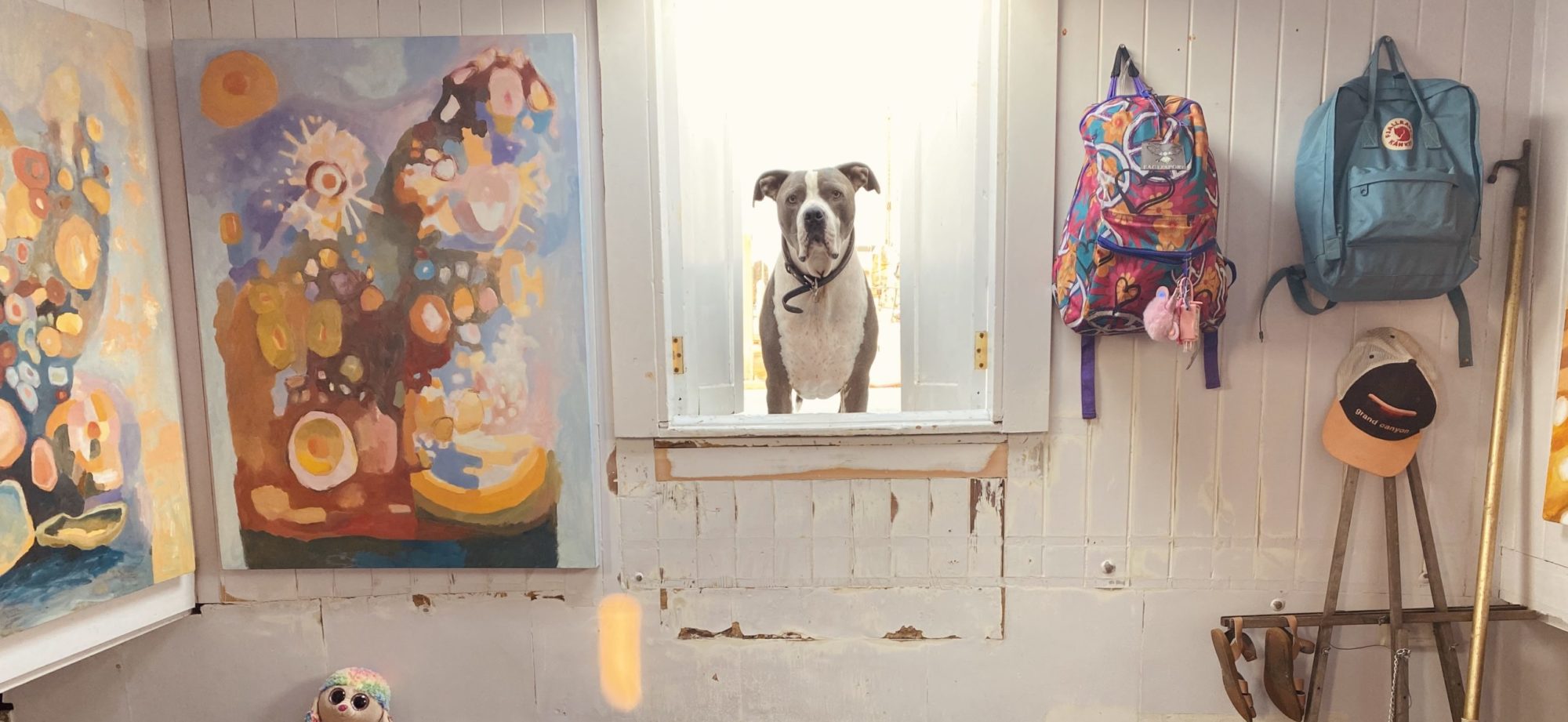We drive to the Pedernales River this morning for a hike. It is quiet around 11:50 except for the last of the churchgoers leaving mass. We cruise under a weary, overcast sky that echoes a landscape hardly awake from winter, except for a lone quince tree blazing pink alongside a truckstop. 290 is growing. What was once a frontier escarpment of limestone and prickly pear is now claimed property of “Muirwood” and “Oak Haven” and the mycelium of other residential real estate developments. But the road itself is still old. We climb and descend each hill like a motorboat on choppy water, tossed about by the scars of traffic and extreme temperatures on the road, our eyes following the varicose veins of long asphalt-filled cracks in the pavement. Scores of Open House signs are everywhere, in short trains of five or six (per builder) they picket the shoulder. There’s a balmy southern breeze and the American flag at the Pulte Highpointe Information Center is at full-mast, waving gloriously. I wonder how many prospective homeowners will visit this trailer today. A part of me can understand how a person would appreciate a home, like the ones I see beyond the trailer, sitting on two green acres and surrounded by white ranch fencing. Perfect for your one-horse family and sidekick goat.
People driving along this road must buy a lot of pottery, rustic metal art and deer antlers; every other store has a side yard filled with chimineas and yard art. Sheet metal silhouettes of cowboys leaning against imaginary walls are among them, so you could (if you wanted to) lean one of those buckaroos against the entrance to your ranch, right there next to the gate. So everyone would know your home was cowboy-friendly, supporting all cowboy-related endeavors.
Damon used to work on the King Ranch. When he was in high school, he had many different roles on the ranch, and his least favorite was the caballero duty of processing freshly-purchased cattle for their new life on the King Ranch. And since he worked during the summers, I’ll begin the description of setting to include blistering heat and dust. Add to that, a two-foot layer of bull shit to stand in (and I mean literally), the smell of burnt flesh, the bustling sounds of hydraulics and metal and groaning cattle.
There’s a short list of duties to perform on the newly-purchased stock: a bloodbath of dehorning, branding, castrating and immunizing. You corral cow into the chute with a cattle prod. If it’s female, the most effective way to move her is to stun her with a cattleprod to the clit (I kid you not). If the cow has horns, you take a large pair of tree pruners and slam, slam, slam them together until the horn lops off, trailed by a river of blood from the marrow (since the horns are, after all, a part of the cow’s skull). While the cow is bleeding out, you take a branding iron and burn the famous running W onto its hide (a cow may have many brands over the course of his or her life). Then, if it’s a bull, you have to castrate it. It’s a systematic thing, really: you slice with a razor blade, pull them out. Period. Lastly, you immunize. If you look up occasionally while injecting, you can pound the huge hypodermic needle accidentally into your own leg, as Damon did. While all of this is going on, the Mexican laborers will take a few testicles and fry them over the same fire that’s heating the branding irons, a sort of freak show snacking. And at the end of the day, the laborers will often take a long latex rubber glove, the kind used for artificial insemination, and fill them with the leftover balls to take home. They’ll leave, smiling and proud, holding a bloody bag of bluish-pink cow balls to cook up later, for themselves? For their family?
Yes, we are in the middle of country with a capital K, as in Kountry Kitchen, Kountry Klutter and Hill Kountry Kabins. I had to retype these names a few times to get it right. It was difficult.
The river is low. The river bottom is worn smooth, and deep crevasses bore through the bedrock like swiss cheese. I hold my breath as I boulder with Chas in the backpack over deep divides, and gasp when Ford leans over edges, peering into the whirlpools. We stop to investigate fossils, embedded everywhere along the riverbottom terrace.
On our walk back up the trail, I stop in my tracks to listen. I hear a slight symphony beyond our parade of noise: Ford is belting out more White Stripes, while Chas is simultaneously repeating Dvorak’s New World Symphony (to the three syllables “Hi Daddy, Hi Daddy,” over and over again–amazing in itself!). Everyone stops, and we all hear it, the distant sound of geese underwater. Looking up, we see birds flying in V-formation, due North, but they are clearly not geese. In a less-focused, more carefree jaunt, these are actually Sandhill cranes flying at about 2000 feet. We watched as they flew over the river, paused, and dissociated into a flowing fabric of cranes, wafting upwards on thermals in freeflowing spiral, resting their wings as they ascended. For about three minutes or so they did this, until one set course and the rest followed, straight into V-formation once more.
We learned three new things on the longish return hike uphill:
1. open-toed sandals and sand do not really mix well, according to a 4 year-old.
2. Ford will knock down any structure, no matter how sacred, to prove his power over inanimate objects.
3. Chas will always attempt to get in the water, so never take him out of the backpack without preparation.












